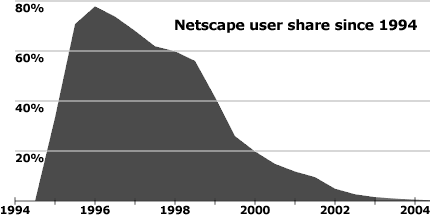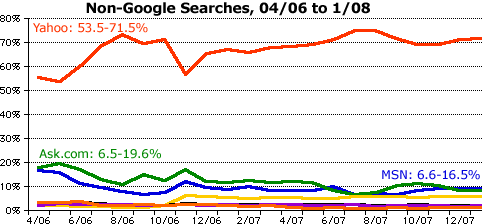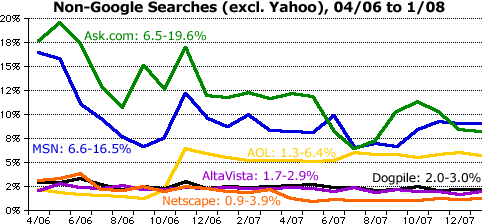Mac Musings
Acquiring Yahoo: Microsoft Is Playing the Same Old Game
Daniel Knight - 2008.02.04
The more things change, the more they stay the same.
Unable to compete with Google using its own resources, Microsoft has made a bid to purchase Yahoo, the second-place Internet search engine.
According to our site logs, 3.4-3.8% of our search engine traffic comes from Yahoo. Microsoft's own search engine has recently taken third place from Ask Jeeves (Ask.com), both currently at the 0.4% mark. AOL is below the 0.3% mark, and the rest are barely blips on the radar.
Some things never change: Microsoft has a 30 year history of copying what it can, leveraging its dominance, and buying into markets it can't take over on its own.
Beginnings: Microsoft BASIC
Microsoft got its start selling a BASIC interpreter for the MITS Altair 8800, the first microcomputer. The program was created on an Altair emulator developed by Paul Allen and running on a DEC PDP-10. Biil Gates spent two months creating the first version of Microsoft BASIC, which remarkably ran flawlessly the first time it was installed on an Altair.
Microsoft BASIC became the de facto standard for personal computers, although in slightly different versions for different machines. The Commodore 8-bit computers included a version Microsoft BASIC (1977), and Apple also licensed a version, named Applesoft BASIC, to replace the Integer BASIC that Steve Wozniak had created for the original Apple II. Atari adopted Microsoft BASIC for its 8-bit personal computers. M-BASIC also made its way onto CP/M computers and was built into the computer that changed the entire personal computing industry: the IBM PC of 1981. BASIC lives on today as Microsoft Visual Basic.
The original Microsoft BASIC was similar to the BASIC used on DEC microcomputers, and to the best of my knowledge Gates and Allen never sought permission or obtained a license to market a version of the BASIC language, although BASIC seems to have been more or less the equivalent of today's open source software.
Since the creators of BASIC had made their language freely available, early hobbyists felt Microsoft BASIC should also be free, and it became the first widely pirated computer software, leading to Bill Gates' Open Letter to Hobbyists, which was published in the Homebrew Computer Club Newsletter dated February 3, 1976. (This was two months before Steve Jobs and Steve Wozniak incorporated Apple Computer.)
Microsoft developed FORTRAN, COBOL, and Assembly Language compilers in 1987, and the company was known as a programming language company, as it had no other products at the time. And the company had its first taste of monopoly, as the variants of Microsoft BASIC completely dominated the field.
Branching Out
Microsoft began selling consumer software, notably the Olympic Decathlon and Adventure games (the latter rooted in the Colossal Cave Adventure created by William Crowther), in 1979. This was the same year that MS BASIC was ported to the 8086/8088 CPU, which would become the heart of the IBM PC two years later.
The world's first spreadsheet program, VisiCalc, became a huge hit on the Apple II, moving the personal computer into the office, and WordStar was the dominant word processor of the day. A program called dBase was growing into the first widespread database software.
Microsoft marketed its first hardware product in 1980. The Microsoft Z-80 SoftCard plugged into a slot in the Apple II and allowed Apple users to run CP/M software designed for the business world. Microsoft also released its first Unix-like operating system, Xenix, that year, as well as a Pascal compiler (Pascal was a hot language in that era).
The New Standard
Recognizing the potential of the personal computer industry, IBM decided to enter the field. Uncertain how well it would fare in the fledgling industry, IBM elected to use off-the-shelf components and license operating systems from other, minimizing its investment in an area new to the company.
IBM licensed Microsoft BASIC, which was built into the PC's ROMs, and PC-DOS (developed by Microsoft and essentially a port of Digital Research's CP/M) was one of three operating systems offered with the new computer. The UCSD p-System was never popular, and the official CP/M-86 operating system sold for a lot more than PC-DOS, which became the de facto standard.
Fortunately for Microsoft, IBM had not asked for an exclusive license to the operating system, so when other 8088- and 8086-based computers came to market, the company was free to sell MS-DOS versions compiled for that hardware. Between that and IBM's decision to use off-the-shelf parts, the PC compatible industry quickly developed, and Microsoft mushroomed into a powerhouse as DOS PCs dominated the field.
GUI
At the same time, Apple had two projects underway to develop next generation computers that would eventually supplant the Apple II. The Lisa project aimed for the business market, and it came to market in 1983 with a $10,000 price tag and an integrated software suite. Lisa introduced the mouse and graphical user interface (GUI) to the world of personal computing.
The Macintosh project was coming into focus as a way to take those ideas and reach a broader market. It was in 1981 that Steve Jobs first let Microsoft take a "sneak peak" at the project, and Microsoft was brought on board to develop software for the Macintosh, which came to market in 1984.
Multiplan, Microsoft's first spreadsheet software, came to market in 1983; it would be the first spreadsheet for the Macintosh, and it worked with the Microsoft Mouse, also introduced in 1983. This was also the year that Microsoft Word 1.0 was released and Windows was previewed.
The Mac and Windows
The Macintosh was introduced in January 1984, and it shipped with MacWrite, a word processor, and MacPaint, the Mac's first paint program. Microsoft BASIC and Multiplan were immediately available, and Word, Chart, and File came to market later in the year. Later in the year, Microsoft unveiled a new spreadsheet program for the Macintosh, Excel.
The first version of Microsoft Windows reached the market in 1985, and it was a pale imitation of the Mac OS. But it ran on computers people already owned, and it ran in DOS, so users could keep using their older DOS-based programs as they migrated to Windows. Excel was ported to Windows, and Multiplan was left to languish.
Windows 1.0 was not a commercial success, and Windows 2.0 (1987) improved things a bit. It wasn't until Windows 3 (a.k.a. Windows 386, and the first version with multitasking) arrived in 1990 that Windows began making inroads. Windows 95 (1995) was the first version that was generally considered competition for the Mac OS, which was already over 10 years old, and many magazines did side-by-side comparisons.
Of course, it wasn't technical superiority that made Windows the standard; it was the fact the people were already using the hardware that ran it. They could easily transition from DOS to Windows, while transitioning to the Mac was a much more difficult process.
Windows so dominated the PC market that it was widely viewed as a monopoly, and Microsoft was not above leveraging its dominance in operating systems to achieve dominance in other areas. To this day Word and Excel are the world's most popular word processing and spreadsheet programs - even on the Mac.
The Web Browser
The World Wide Web was developed as a way for users to view information on the Internet. Developed by Tim Berners-Lee (on a NeXT Cube) in 1990, it was followed by NCSA Mosaic, the first popular Web browser, in 1993. Nothing has changed the face of personal computing in the past two decades as much as the Internet and Web browsers.

The first commercial browser was Netscape Navigator, introduced in 1994, and it quickly came to dominate the Web browser market - especially since it could be downloaded and used without paying the license fee. For a brief time, Netscape owned over 75% of the browser market.
Even though most users used Netscape without paying for it, Microsoft couldn't stand to have someone else own a potential market, so in late 1994 Microsoft licensed the Mosaic browser, which became the basis for Internet Explorer (IE). IE 1.0 was released with the "Microsoft Plus!" package for Windows 95 in August 1995. Version 2.0 came out in November, and version 3.0 was released in August 1996. Internet Explorer was ported to the Mac in 1991, and it became the Mac's default browser in 1997.

In contrast to Netscape, which asked for a license fee if Netscape was being used in a commercial setting, Microsoft made Internet Explorer absolutely free. And once it began to gain market share, Microsoft added new features to IE, and soon we had websites developed especially for IE (or Navigator, which did the same thing), breaking the original dream of the World Wide Web that pages could be viewed on any platform.
As has so often been the case, Microsoft has identified a market, found a toehold, and grew its share by doing things like integrating IE with Windows and creating proprietary extensions to industry standards to lock others out of the market.
Search Engines
When I first started using the Web circa 1996, the hot search engines were WebCrawler, InfoSeek, Lycos, AltaVista, HotBot, Ask Jeeves, and Yahoo. In those days, you generally had to let a search engine know that your site existed and ask to be indexed. I made heavy use of AltaVista and Yahoo in those days.
Dogpile got its start in 1996 as one of the first "metasearch" engines, a website that polls several different search engines (rather than creating its own search engine) looking for results. Many of the lesser known search engines have gone the same route, profiting from the work of others.
Then came Google. Rather than ask publishers to submit sites, Google crawled the Web in search of pages and links. What set Google apart from the pack was that it weighted its results based on the number and quality of links to a page on the Web (Google calls this PageRank).
Google enhanced the search experience with a very simple, fast loading home page, and it wasn't too long before a lot of us made Google our home page. Google was soon incorporated into browsers as a search tool, which made it even easier to access the world's most popular search engine.
Microsoft + Yahoo
According to our site logs, Google completely dominates the search engine field with over 93% of the market. Yahoo, Microsoft's current acquisition target, accounts for less than 4% of search engine traffic to Low End Mac, and Microsoft Live Search (a.k.a. MSN Search) trails at under 0.5%. It has only passed Ask.com in the past two months. Between them, all of the other search engines - including Ask.com, AOL, Dogpile, AltaVista, and many, many more - account for less than 3% of our visitors who come through a search engine.

I won't assume that traffic to Low End Mac is normative, as the majority of our visitors are not using Windows or Internet Explorer. It should be no surprise that over half of our readers use Macs. And it may be a surprise that Apple's Safari browser, the default under OS X, is not the most used browser among site visitors - nor is Internet Explorer. It's Firefox that 35.2% of our visitors use, with Safari following close behind at 31.4%. Microsoft Internet Explorer holds a solid third place at 24.4%, and Opera takes fourth place (not counting Mozilla variants) at 2.0%.
The reason I point this out is that Safari and Netscape use Google as their default search engine, something you know Microsoft is never going to do with Internet Explorer. And Internet Explorer is the dominant Web browser, so that would skew results toward MSN search and away from Google for sites that don't have a strong Mac, Unix, or Linux focus.
However you look at it, Microsoft Live Search trails Google by an incredible amount, even among those who use Windows and Internet Explorer. The numbers for non-Google searches are so small, in fact, that I've created a chart that shows only the other search engines with over 1% (according to our site logs).

When we take Google out of the picture, Yahoo totally dominates, with Ask.com and MSN trailing by quite a bit. Of course, our results are for a Mac-oriented website.
With 43.5% of our visitors using Windows and 24.4% using Internet Explorer, 56% of Windows users coming to LEM choose Internet Explorer. We can assume that would be higher for more general interest websites, but even then IE has less than 80% market share. Based on that, we can estimate that Live Search might account for 20-50% of non-Google searches. Let's be generous and say it's 35% - that's about half of Yahoo's typical share.
Because Yahoo dominates non-Google searches just as Google dominates all searches, let's look even closer at search engine visits, this time taking Yahoo off the chart so you can actually see the lines for AOL, AltaVista, Dogpile, and Netscape:

Why Does Microsoft Want Yahoo?
The big question is, "What does Microsoft hope to gain by acquiring Yahoo?" The answer: They hope to more than double Microsoft's share of the search engine market. Our guess is that between Yahoo and MSN Live Search, Microsoft would own 80-90% of the non-Google search engine market. That's still a distant second to Google's 80% or so share of the entire search engine market, but it more than doubles Microsoft's ability to monetize search engine results.
Microsoft hates being second fiddle to anyone, so it has to grate at the company to be third place behind upstart Google and longtime player Yahoo. By purchasing Yahoo, Microsoft will become a solid second in the market and also own another cash cow.
The Value of Yahoo
Yahoo is a lot more than a search engine and portal. The company provides free email accounts, instant messaging, online personals, and many other services. Free email and instant messaging are two other areas where Microsoft has not been the dominant player, so this would further cement its presence in those two markets.
My guess is that the big reason Microsoft wants Yahoo is bragging rights. Since it can't create a search engine on its own that people want to use, it can buy a more popular one. Since it can't seem to recreate the Hotmail phenomenon (Hotmail itself being another example of Microsoft buying into a market), it can buy a very successful free email provider. And since it can't dominate instant messaging on its won (AOL, Yahoo, and Microsoft have been duking it out in that market for years), acquiring Yahoo is one way to possibly take first place in that market.
The Danger to Yahoo Users
I am not a Windows user, and I rarely use Microsoft Word, but I am a Yahoo user. I've used its messaging service for years, used to play a lot of online euchre at Yahoo Games, was a member of Yahoo Personals for a year or so, and use Yahoo Mail daily.
Although more popular than Live Search, Yahoo Search takes a back seat to Google, and Yahoo's free email service, while nice, does a horrid job of identifying and filtering spam compared with Google's free Gmail service. (I love Yahoo's email interface and hate Google's, but the superior spam filtering could win me over.)
If Microsoft were to acquire Yahoo, it could mean big changes for users. They might end up phasing out Yahoo email and messaging, rolling both services into Live Mail and Microsoft Messenger - and forcing users to migrate from email accounts and online messaging IDs we've used for years.
Why? Because I can't see Microsoft maintaining two separate and incompatible systems. And that being the case, who is Microsoft more likely to cut off, longtime Microsoft Mail and Messenger users or those who use the company Microsoft has acquired?
Buying Yahoo may be good for Microsoft, but I don't see good things ahead for users if Microsoft does buy Yahoo.